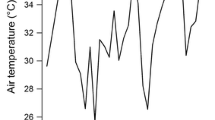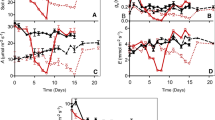Abstract
Interest has developed in the potential of mulberry (Morus alba), a woody perennial, for revegetating the hydro-fluctuation belt of the Three Gorges Reservoir due to its resistance to water-logging stress. To be useful, the trees must also be able to withstand dry conditions in summer when temperatures can be very high and droughts become severe quickly. Here, we report a study in which mulberry seedlings were grown in a greenhouse under a variety of simulated soil water conditions reflecting potential summer scenarios in the hydro-fluctuation belt of the Three Gorges Reservoir Area. We compared the responses of two pretreatment groups of mulberry seedlings to different levels of drought stress. The pretreatment groups differed with respect to drought hardening: the daily-managed (DM) group had relative soil moisture held constant in the range 70–80 %, while the drought-hardened (DH) group had relative soil moisture held constant at 40–50 %. Following the month-long pretreatment of seedlings, the two groups of young trees (DM and DH) were then respectively subjected to three levels of drought stress for a month: normal watering, moderate drought stress, and severe drought stress. A series of measurements comparing the physiological status of the plants in the two groups were then made, and the following results were obtained: (1) As drought stress increased, the heights, base diameters, root surface areas, photosynthetic rates (Pn), stomatal conductances (Gs), and transpiration rates (Tr) of the mulberry trees in both groups (DM and DH) decreased significantly, while the specific root area and abscisic acid (ABA) contents had increasing trends. Root activity and instantaneous water use efficiency of mulberry trees in both groups (DM and DH) were all raised under drought stress conditions than under normal watering, but the root/shoot ratio and leaf water potential were lowered. (2) At the same level of soil water content, the heights, base diameters, root/shoot ratios, root surface areas, specific root areas, photosynthetic rates (Pn), stomatal conductances (Gs), and transpiration rates (Tr) of the young mulberry trees in the DH were all significantly higher than those of the control group (DM). Leaf water potential, instantaneous water use efficiency, and abscisic acid content of DH were all significantly lower than DM. Under different degrees of drought stress, the growth of mulberry trees will be inhibited, but the trees can respond to the stress by increasing the root absorptive area and enhancing capacity for water retention. Mulberry trees demonstrate strong resistance to drought stress, and furthermore drought resistance can be improved by drought hardening during the seedling stage.







Similar content being viewed by others
References
Baxter RM (1977) Environmental effects of dams and impoundments. Annual Review of Ecology and Systematics 8:255–283
Becker D, Hoth S, Ache P (2003) Regulation of the ABA sensitive Arabidopsis potassium channel gene GORK in response to water stress. FEBS Letters 554:119–126
Brown KW, Jordan WR, Thomas JC (1976) Water stress induced alterations of the stomatal response to decreases in leaf water potential. Physiologia Plantarum 37(1):1–5
Burgess KS, Husband BC (2006) Habitat differentiation and the ecological costs of hybridization: the effects of introduced mulberry (Morus alba) on a native congener (M. rubra). Journal of Ecology 94:1061–1069
Correia PJ, Martins-Loucão MA (1995) Seasonal variations of leaf water potential and growth in fertigated carob-trees (Ceratonia siliqua L.). Plant and Soil 172:199–206
Cutler JM, Rains DW (1977) Effect of irrigation history on response of cotton to subsequent water stress. Crop Science 17:329–335
Eissenstat DM (1991) On the relationship between specific root length and the rate of root proliferation: a field study using citrus rootstocks. New Phytologist 118:63–68
Feng Y, Wang YR, Hu XW (2011) Effects of soil water stress on seedling growth and water use efficiency of two desert shrubs. Acta Prataculturae Sinica 20(4):293–298 (in Chinese)
Franco AC, Nobel PS (1990) Influences of root distribution and growth on predicted water uptake and interspecific competition. Oecologia 82:151–157
Gallagher JN, Biscoe PV, Hunter B (1976) Effects of drought on grain growth. Nature 264:541–542
Garcia-Mata C, Lamattina L (2001) Nitric oxide induces stomatal closure and enhances the adaptive plant responses against drought stress. Plant Physiology 126(3):1196–1204
Guo XS, Shan L (1994) Effects of drought hardening in earlier-period on the water use efficiency of millet. Acta Agronomica Sinica 20(3):352–356 (in Chinese)
He XB, Xie ZQ, Nan HW, Bao YH (2007) Developing ecological economy of sericulture and vegetation restoration in the water-level-fluctuating zone of the Three Gorges Reservoir. Science & Technology Review 25(23):59–63 (in Chinese)
He YK, Wang YW (2001) Analysis on characteristics and variance of drought in Chongqing Three Gorges Reservoir Region. Mountainous Area Development (12):24-26 (in Chinese)
Hetherington AM, Woodward FI (2003) The role of stomata in sensing and driving environmental change. Nature 424:901–908
Hoogenboom G, Huck MG, Peterson CM (1987) Root growth rate of soybean as affected by drought stress. Agronomy Journal 79(4):607–614
Huang BR, Fry JD (1989) Root anatomical, physiological, and morphological responses to drought stress for tall fescue cultivars. Crop Science 38(4):1017–1022
Huang XH, Yin XH, Liu Y, Li JX, Xiong XZ, Chen Y (2012) Effects of drought stress on the growth of mulberry (Morus alba L.) trees in the hydro-fluctuation belt of the Three Gorges Reservoir Area. Journal of Chongqing Normal University (Natural Science) 29(3):151-155
Koshita Y, Takahara T, Ogata T, Goto A (1999) Involvement of endogenous plant hormones (IAA, ABA, GAs) in leaves and flower bud formation of Satsuma mandarin (Citrus unshiu Marc.). Scientia Horticulturae 79:185–194
Leung J, Giraudat J (1998) Abscisic acid signal transduction. Annu Rev Plant Physiol Plant Mol Biol 49:199–222
Li JW, Wang JX, Zhang ML, Ji ZB, Xu S (2009) Effect of drought and rewater on leaf water potential of Robinia pseudoacacia. Journal of Northwest Forestry University 24(3):33–36 (in Chinese)
Liu Y (2011) Application prospect of mulberry plants to vegetation restoration in Three Gorges Reservoir Area. Science of Sericulture 37(1):93–97 (in Chinese)
May LH, Milthorpe EJ, Milthorpe FL (1962) Presowing hardening of plants to drought. Field Crop Abstracts 15:93–98
Mcainsh MR, Brownlee C, Hetherington AM (1990) Abscisic acid-induced elevation of guard cell cytosolic Ca2+ precedes stomata closure. Nature 343:186–188
Meyer WS, Green GC (1981) Plant indicators of wheat and soybean crop water stress. Irrigation Science 2:167–176
Miao CY, Chen TF, He BH (2005) Study on mulberry effect of soil and water conservation applying in purple soil. Journal of Soil and Water Conservation 19(1):117–123 (in Chinese)
Ministry of Water Resources of the People’s Republic of China (2009) Standard of classification for drought severity SL424-200. China Water Power Press, Beijing, China (in Chinese)
Pei TQ, Wang LA, Han Y, Huang C, Gong X (2008) Distribution characteristics form soil profile heavy metal of water-level-fluctuating zone in Three Gorges Reservoir Area. Research of Environmental Sciences 21(5):72–78 (in Chinese)
Proffitt APB, Berliner PR, Oosterhuis DM (1985) A comparative study of root distribution and water extraction efficiency by wheat grown under high- and low-frequency irrigation. Agronomy Journal 77(5):655–662
Qin J, He NJ, Huang XZ, Xiang ZH (2010) Development of mulberry ecological industry and sericulture. Science of Sericulture 36(6):984–989 (in Chinese)
Reddy AR, Chaitanya KV, Vivekanandan M (2004) Drought-induced responses of photosynthesis and antioxidant metabolism in higher plants. Journal of Plant Physiology 161:1189–1202
Samarah NH (2005) Effects of drought stress on growth and yield of barley. Agronomy for Sustainable Development 25(1):145–149
Smucker AJM, Nunez-Barrios A, Ritchie JT (1991) Root dynamics in drying soil environments. Belowground Ecol 2:4–5
Schnitzler A, Hale BW, Alsum EM (2007) Examining native and exotic species diversity in European riparian forests. Biological Conservation 138:146–156
Unger PW, Kaspar TC (1994) Soil compaction and root growth: a review. Agronomy Journal 86:759–766
Van-Loon CD (1981) The effect of water stress on potato growth, development, and yield. American Journal of Potato Research 58(1):51–69
Wang SH, Du YJ (2008) Effects of exogenous hormones on photosynthetic parameters of strawberry under drought stress. Chinese Agricultural Science Bulletin 24(12):367–371 (in Chinese)
Xiao LT, Wang SG (2005) Experimental technology of plant physiology. China Agriculture Press, Beijing (in Chinese)
Xoconostle-Cázares B, Ramirez-Ortega FA, Flores-Elenes L, Ruiz-Medrano R (2010) Drought tolerance in crop plants. American Journal of Plant Physiology 5(5):1–16
Xu HP (1989) Effects of drought hardening before sowing on the plant drought resistance and its physiological basis. Agricultural Research in The Arid Areas (2):87-94 (in Chinese)
Xu QB, FU WL ,Sun L ,Tan B, Wang XY (2009) Study on soil anti-erodibility for the water level-fluctuating zone in Three Gorges Reservoir Area. Research of Soil and Water Conservation (5): 13-18 (in Chinese)
Zhang AM, Geng GD, Yang H, Jiang H (2010) Effects of drought stress on the physiological parameter of pepper seedling. Journal of Mountain Agriculture and Biology 29(1):35–38 (in Chinese)
Zhang Q, Luo Y, Liao YM, Chen LJ, Liu HB, Han RQ (2007) Analysis to the cause of high temperature and drought in summer in the Three Gorges Reservoir Area in 2006. China Three Gorges Construction (2):89-91 (in Chinese)
Acknowledgments
The authors thank Martin Willison of Dalhousie University and Marinus J.A. Werger of Utrecht University for the valuable comments on the manuscript, and Lin Feng of Southwest University for providing technical assistance. The experimental work was supported by the Key Laboratory of the Three Gorges Reservoir Region’s Eco-Environment (Southwest University), Ministry of Education and Chongqing Key Laboratory of The Three Gorges Area Forest Ecology Protection and Restoration.
Author information
Authors and Affiliations
Corresponding author
Additional information
Responsible editor: Philippe Garrigues
Rights and permissions
About this article
Cite this article
Huang, X., Liu, Y., Li, J. et al. The response of mulberry trees after seedling hardening to summer drought in the hydro-fluctuation belt of Three Gorges Reservoir Areas. Environ Sci Pollut Res 20, 7103–7111 (2013). https://doi.org/10.1007/s11356-012-1395-x
Received:
Accepted:
Published:
Issue Date:
DOI: https://doi.org/10.1007/s11356-012-1395-x




